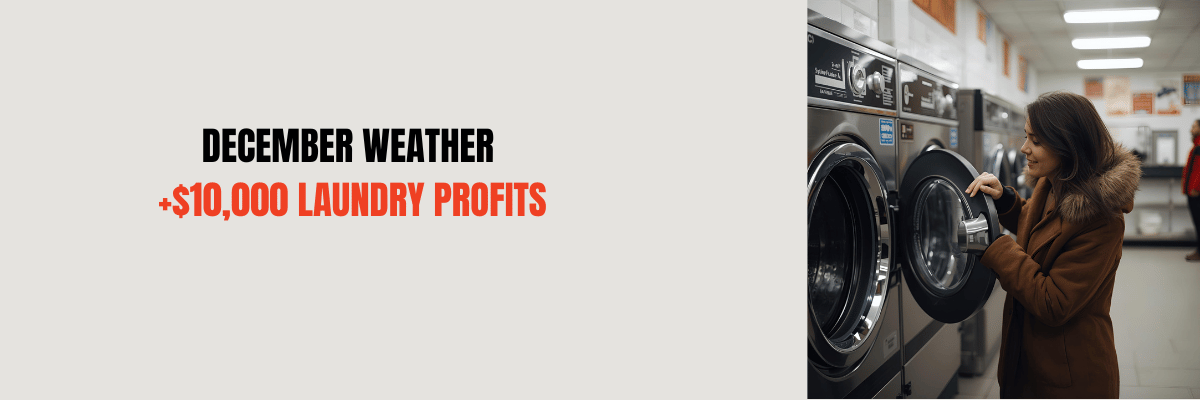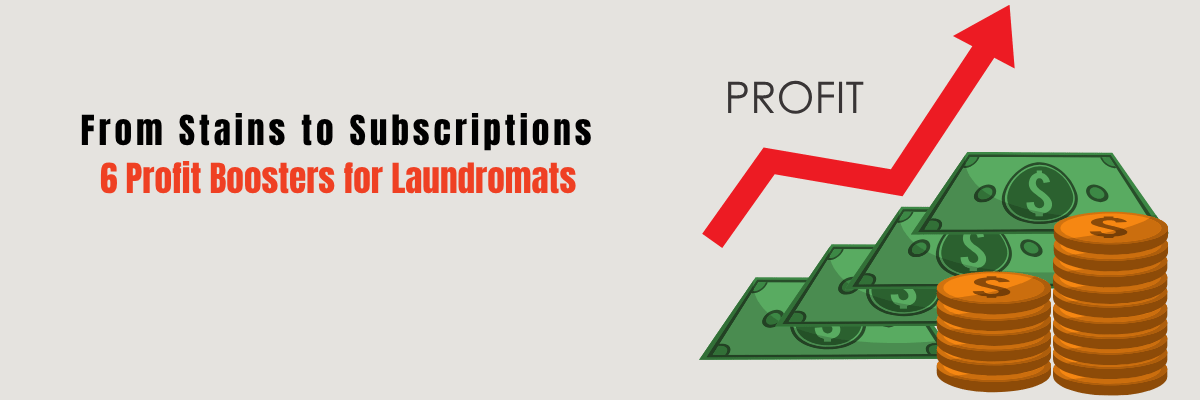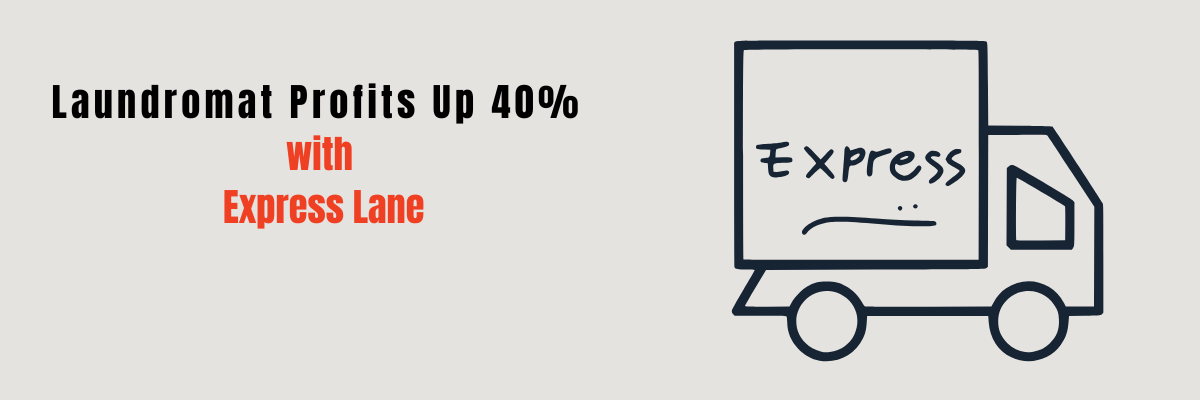The Hidden Goldmine: 7 Unexpected Revenue Streams Your Laundromat is Missing


Your laundromat doesn't have to be just about washing clothes. While competitors focus on spin cycles and soap dispensers, you could be building a diverse revenue portfolio that keeps cash flowing even during slow periods.
If you're like most laundromat owners, you're wondering: "How do I make more money without buying more machines or raising prices again?" The answer lies in the untapped opportunities sitting right in front of you.
Some smart owners have quietly been building additional income streams that bring in $5,000 to $20,000 extra every month. They're not just washing clothes anymore - they're running mini business empires from the same space you have right now.
7 Profit-Boosting Strategies Laundromat Owners Swear By
Here are 7 proven strategies successful laundromat owners across America are using to dramatically increase their monthly profits.
1. Tap into the $12 Billion Short-Term Rental Boom
Why This Matters
The short-term rental market is experiencing explosive growth, and laundry is the biggest headache for hosts. With 2.05 million active properties doing an average of 47 linen changes monthly, there's massive demand for reliable laundry services.
Host Pain Points Creating Your Opportunity
• 73% spend 3-5 hours on laundry between each guest
• 89% have lost bookings due to dirty or unavailable linens
• 71% need emergency same-day service during peak seasons
• 78% report inconsistent turnaround times with current providers
Implementation Strategy
Phase 1 (Week 1-2): Research local market using AirDNA, identify properties with 15+ monthly bookings
Phase 2 (Week 3-4): Create tiered pricing structure:
• Basic service: $2.50/lb (24-hour turnaround)
• Premium service: $3.50/lb (same-day service)
• Emergency service: $5.00/lb (4-hour turnaround)
Phase 3 (Week 5-8): Direct outreach to Superhosts, offer free trial service and 10% referral commissions
Revenue Potential
$1,500-4,500 monthly from 3-5 properties | $8,000-15,000 monthly from 10 medium properties
2. Monetize the Remote Work Revolution ($22 Billion Opportunity)
Why Now is Perfect
With 73.1% of workers now flexible (remote/hybrid), they're spending an average of 118 minutes in laundromats. Many are desperate to turn "waiting time" into productive work time.
Remote Work Evolution
What Remote Workers Need
• 67% struggle with home distractions and will pay $15-30/day for alternative workspace
• 54% feel isolated working from home daily
• 78% seek "productive waiting time" opportunities
• 43% specifically need professional meeting spaces
Implementation Plan
Month 1: Install high-speed WiFi, comfortable seating, charging stations ($3,000-5,000)
Month 2: Launch day passes ($10-15) and monthly memberships ($45-75)
Month 3: Add premium services like printing, coffee partnerships, quiet zones
Revenue Potential
$800-3,000 monthly + increased customer loyalty and laundry volume
3. Launch Subscription Laundry Services
Market Growth Reality
By 2025, 61% of laundry spending comes through subscription services. The market has grown from $8.2B (2020) to $17.8B (2025).
Income-Based Adoption Rates (2025)
The Value Proposition
High-income professionals value their time at $50-125/hour. Since laundry takes 3.5 hours monthly, charging $150/month still provides $25+ in time savings value.
Implementation Strategy
Month 1: Create tiered plans:
• Basic Plan: $75/month (wash, dry, fold)
• Premium Plan: $125/month (+ pickup/delivery, stain treatment)
• Luxury Plan: $175/month (+ dry cleaning, repairs, premium products)
Month 2-3: Partner with apartment complexes, office buildings, and busy professionals
Revenue Potential
$1,125-3,750 monthly from 15-25 subscribers | $7,500+ monthly from 50+ subscribers
4. Smart Retail Strategy
The Captive Audience Opportunity
Your customers are stuck waiting 60-120 minutes with limited alternatives. Smart retail turns this captivity into profit.
High-Margin Product Categories
Essential Laundry Items (200-300% markup)
• Travel-sized detergents and fabric softeners
• Stain removers, lint rollers, mesh bags
• Premium hangers and laundry baskets
Convenience Items (150-250% markup)
• Phone chargers, headphones, portable batteries
• Snacks, beverages, coffee
• Reading materials, basic toiletries
Local/Artisan Products (100-200% markup)
• Handmade soaps, candles, crafts
• Local artist items, neighborhood specialties
Implementation Tips
• Place impulse items near change machines and seating
• Use attractive displays with clear pricing
• Rotate inventory based on seasons and customer feedback
• Accept mobile payments for convenience
Revenue Potential
$300-800 monthly (basic setup) | $800-1,200 monthly (optimized retail space)
5. Transform Into a Community Event Hub
Monetize Off-Peak Hours
Most laundromats are underutilized evenings and weekends. Events create revenue while building community loyalty.
Profitable Event Ideas
Family-Friendly Events
• "Fold & Film" movie nights ($5-10 admission + snacks)
• Kids birthday parties ($75-150 rental + extras)
• Craft workshops while clothes wash ($15-25 per person)
Adult-Focused Events
• Book clubs and discussion groups ($5 cover + refreshments)
• Speed dating or singles events ($20-30 per person)
• Pop-up vendor markets (booth rental fees)
Revenue Streams Per Event
• Admission fees: $5-30 per person
• Concessions: $3-8 per person
• Space rental: $50-200 per event
• Vendor fees: $25-75 per booth
Implementation Strategy
Month 1: Start with simple movie nights, test community interest
Month 2: Add craft workshops or book clubs
Month 3: Experiment with vendor markets or private parties
Revenue Potential
$200-600 per event | $800-2,400 monthly with 4-6 events
6. Capture Commercial B2B Clients
The Underserved Market
The U.S. commercial laundry market is $25.9B (2025), growing to $39.2B by 2030. Small businesses are abandoning large providers for local service.
Why Local Wins Over National Providers
• 78% of small businesses report dissatisfaction with large commercial services
• 67% prefer local providers for emergency services
• 74% value flexible contracts over corporate restrictions
• Local providers offer 23-35% cost savings with better service
Target Business Types & Revenue
Implementation Strategy
Week 1-2: Map businesses within 5-mile radius, prioritize high-volume locations
Week 3-4: Create service packages with pickup/delivery, flexible billing
Month 2: Direct outreach with free trial offers and competitive pricing
Month 3: Implement dedicated time slots for commercial clients
Revenue Potential
$2,400-7,200 monthly from 3-6 clients | $10,000+ monthly with 8-12 steady accounts
7. Digital Services Revenue
Technology Creates Premium Value
Customers will pay for convenience, transparency, and modern experiences that traditional laundromats don't offer.
Digital Revenue Opportunities
Mobile App Premium Features
• Priority notifications and cycle alerts ($2-5/month)
• Machine reservation system ($1-3 per reservation)
• Custom wash preferences storage
Payment Convenience
• Mobile payment processing (small convenience fee)
• Loyalty program premium tiers ($5-15/month)
• Automatic refill services
Smart Services
• Real-time machine availability via app
• Remote monitoring and maintenance alerts
• Data analytics for peak hour optimization
Implementation Approach
Phase 1: Basic mobile payment system with small fees
Phase 2: Customer app with free and premium tiers
Phase 3: IoT sensors and advanced features
Revenue Potential
$200-600 monthly (basic digital services) | $800-1,500 monthly (comprehensive tech stack)
Your 90-Day Implementation Roadmap
Days 1-30: Foundation Building
• Week 1: Audit current space and identify underutilized areas
• Week 2: Research local STR properties and nearby businesses
• Week 3: Install basic infrastructure (WiFi, POS system, seating)
• Week 4: Set up simple retail displays and inventory
Days 31-60: Service Launch
• Week 5-6: Launch 2 easiest revenue streams (retail + basic B2B outreach)
• Week 7: Host first community event to test market response
• Week 8: Begin Airbnb partnership outreach with trial offers
Days 61-90: Scale and Optimize
• Week 9-10: Analyze performance data, optimize successful services
• Week 11: Add subscription service or co-working space based on demand
• Week 12: Plan Year 2 expansion and advanced service rollout
Frequently Asked Questions
Q: Do I need special licenses for pickup/delivery services?
A: Yes, most states require:
• Commercial vehicle permits for regular routes
• Commercial auto insurance ($50-150 monthly increase)
• Business license amendments (78% of municipalities)
• DOT numbers for vehicles over 10,000 lbs in some states
• Budget $500-2,000 initial compliance, $200-400 monthly ongoing
Q: What about food service regulations?
A: Regulations vary by state:
• Pre-packaged items: Usually no license required
• Coffee service: Food handler's permit needed ($45-85)
• Full food service: Restaurant license required ($200-2,500)
• Alcohol service: Separate licensing ($500-3,000 annually)
Q: What insurance coverage do I need?
A: Essential coverage includes:
• General liability increase to $1M for partnerships
• Commercial auto for delivery services
• Product liability for retail sales
• Business interruption for expanded operations
Q: How do I manage multiple services without overwhelming current operations?
A: Use sequential launch strategy:
• Never launch more than 2 services simultaneously
• Start with lowest-complexity options (retail, corporate)
• Add 0.5-1.0 FTE staff per major service addition
• Implement simple systems before advanced ones
Q: What's the real cost breakdown?
A: Realistic investment by service:
Q: How do I price competitively without starting price wars?
A: Focus on value-based pricing:
• Convenience commands 35-60% premium over basic service
• Reliability justifies 25-40% premium
• Speed (same-day) supports 80-150% premium
• Bundle services to reduce price sensitivity by 43%
Q: What technology do I actually need vs. nice-to-have?
A:
Essential Year 1:
• Basic POS with inventory tracking ($50-150/month)
• Customer communication platform ($30-80/month)
• Simple scheduling Laundromat Management software ($40-100/month)
• Basic accounting integration ($20-50/month)
Optional Year 2+:
• Advanced route optimization ($100-300/month)
• Custom mobile app ($5,000-15,000 development)
• IoT machine monitoring ($200-500/month)
• Advanced analytics ($100-400/month)
Q: How do I handle payments for multiple services?
A: Use integrated payment systems:
• Unified processing (2.6-3.5% + $0.10-0.30 per transaction)
• Subscription billing capability
• Mobile payment options
• Corporate invoicing features
• Automatic tax calculation
Q: What if competitors copy my strategies?
A: First-mover advantages include:
• Relationship depth: Partnerships take 18+ months to replicate
• Operational expertise: Service quality requires experience
• Brand recognition: Community presence builds over time
• System integration: Complex operations create switching costs
Reality check: Only 12% of laundromat owners implement diversification, and 34% of those fail due to poor execution.
Q: How do I know if my market can support these services?
A: Market validation framework:
Strong Market Indicators:
• 15,000+ households within 5-mile radius earning $50K+
• 10+ active STR properties nearby
• Less than 2 diversified laundromat competitors
• 30%+ of customers work remotely or own small businesses
Market Assessment Steps:
1. Drive 5-mile radius, count STR properties and small businesses
2. Survey 20 current customers about desired services
3. Check local competition online and in-person
4. Analyze evening customer behavior (laptop usage, wait time activities)
Financial Planning
Q: What financing options exist for expansion?
A: Funding sources beyond bank loans:
Q: What are the biggest financial mistakes to avoid?
A: The "Fatal Five" based on failed expansions:
1. Launching too many services at once (67% of failures)
2. Underestimating labor costs by 40-60%
3. Ignoring seasonal demand variations (50-70% swings)
4. Poor quality control losing 5-7 customers per bad experience
5. Inadequate insurance coverage creating liability exposure
Your Profit Reality Check
Conservative Growth Timeline
Months 1-3: $1,500-4,000 additional monthly revenue
Months 4-8: $3,500-8,000 additional monthly revenue
Year 2: $5,000-12,000 additional monthly revenue
Long-term: $8,000-20,000+ additional monthly revenue
Investment Recovery
• Conservative approach: $15,000-25,000 investment, 6-10 month payback
• Aggressive approach: $35,000-50,000 investment, 8-14 month payback
• Ongoing ROI: Most owners report 300-600% returns by year two
Final Thought
The laundromat of tomorrow isn't just about washing clothes. It's a convenience hub, a coworking space, a retail store, a logistics provider, and a community anchor.
While 88% of your competitors remain focused solely on traditional laundry services, you have an 18-month window to capture multiple revenue streams before the market becomes saturated.
The owners who succeed with diversification aren't necessarily the smartest or best-capitalized - they're the ones who start small, execute consistently, and listen to their customers.






